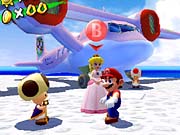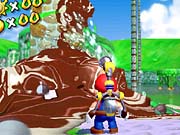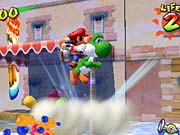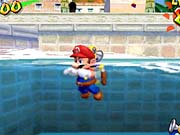Super Mario Sunshine Preview
Read everything we know about Nintendo's highly anticipated sequel to Super Mario 64 in our comprehensive hands-on preview.
Previous Mario games have always been known for their innovation. Super Mario 64 was the first console game to give 3D graphics the spotlight they deserve, and the 2D Mario games have been heralded for creating and perfecting the platforming genre. So it comes as no surprise that there are high expectations for Super Mario Sunshine for the GameCube, the first game to star the energetic plumber on Nintendo's new console. Based upon what has been shown of the game so far, it looks to be an evolution of Super Mario 64 instead of its revolution, but it includes plenty of gameplay mechanics to set it apart from the glut of platforming games available.

Fresh off his latest adventures, Mario decides it's time for a vacation and sets off for a tropical island with his significant other, Princess Peach. Upon touching down on the island, Mario is soon approached by the locals who claim that the once peaceful and clean island has been plagued by pollution, and the perpetrator looks very similar to Mario. Falsely accused of the crime, Mario must try to clean up the pollution to appease the locals while trying to find out just who is behind it all.
You begin the game with the majority of Mario's previous moves in tact. Making Mario jump is accomplished with the A button, and timing your jumps correctly will cause him to perform double or triple jumps. Other Mario staples such as the back flip and side flip have returned and can be performed by running one direction and then quickly pointing the analog stick in the opposite direction and pressing jump. It wouldn't be a true 3D platformer without a butt-stomp maneuver, and jumping and then pressing the L button while in midair performs it. The context-sensitive B button allows Mario to talk with the characters scattered throughout the game, grab objects, or slide on his stomach if you press the button while he's running. The wall jump has also returned, and it is much easier to pull off this time around. You can also make Mario climb trees or perform a new spinning high jump by rotating the analog stick 360 degrees and pressing jump. However, Mario's traditional melee attacks such as his punches and kicks have been removed in favor of a different means of combat.
New to the Mario franchise is a multipurpose water cannon that is mounted on the plumber's back. At present, there are two known uses for the apparatus, and Nintendo has already stated that there will be more. Toggling between the two uses is as easy as tapping the X button. The cannon will spray water forward from above Mario's head, or it can be used to make Mario hover above the ground if you spray it downward. Both actions are initiated by pressing the R button. You can even perform a high or triple jump and then activate the hover capabilities for some added height.

Pressing the R button will cause Mario to spray water while running or walking, while pressing the button in until it clicks will cause Mario to stop and take better aim when you use the analog stick. To refill the cannon's tank, you simply jump into a water source. You can make Mario run and slide in the goop on his belly by pressing the B button, and you can then control him as he quickly slides across its slick surface. Mario can even spray water while sliding, and this technique comes in handy for cleaning up large sections of pollution in a short period of time. Mario can also clean up puddles of the pollution by using the water tank to hover above them. The goop itself is generated by holes in the ground that must be thoroughly doused with water to be destroyed. Doing so will trigger real-time cinemas that show the levels being morphed so that new ways of travel are opened. Graffiti is scattered throughout the levels in the form of red M's painted on the terrain. Cleaning up the graffiti will reward Mario with coins. The water cannon can also be used to propel Mario around on lily pads or to generate momentum while he's holding onto a power line to cause it to swing back and forth and reach new heights. Haphazardly spraying the cannon around the environments can produce interesting results. Trees and other plants will unexpectedly spring from the ground, giving Mario new vantage points to jump from.
As is customary in Mario games, it's fun to simply run around with the portly plumber, jumping off objects and fooling around with the game's physics. And in this sense, the controls are incredibly tight and responsive. Mario will automatically lock on to the power lines scattered throughout the levels, and they react with incredible realism to his movements. Mario will slip and fall on the goop and will be unable to make progress. Despite the fact that the goop is completely random, the hit detection is absolutely perfect. There are context-sensitive areas in the game where Mario will step on a particular spot and be shot skyward, and there has also been footage released of Mario riding the green dinosaur, Yoshi.
There were several boss fights included in the version of Super Mario Sunshine we were allowed to play. One asks you to spray a small sapling with water, causing it to grow and knock a large caterpillar on its back. Mario must then jump on top of the caterpillar and butt-stomp one of its segments. Rinse and repeat. Another boss fight takes place inside a huge column, where a massive piranha plant must be fought as it vomits up huge amounts of goop and smaller piranha plants attack Mario from the ground. Mario must shoot water into the large piranha plant's mouth until it becomes full and falls on its side. Then it's time to give the plant a good butt-stomp. Another area has Mario on a reflective disc with three enemies, and using the disc's lever physics you must butt-stomp one side of the disc to send enemies on the other side of the disc careening into the air.

The attention to detail in the gameplay is matched by the graphics, though they still fall short of games like Star Fox Adventures and The Legend of Zelda. But the processing power is used in different ways in Super Mario Sunshine to provide some realism in an otherwise surreal setting. Mario's footsteps can be seen in the goop, and creatures will morph out of the ooze and attack. Mario will become covered in the pollution after sliding around in it on his belly, and when you then jump into one of the water sources the pollution can be seen dissolving into the water. The draw distance for the levels is amazing with no draw-in whatsoever, and a convincing distance blurring effect is instituted to haze objects on the horizon. There's also a nice blurring effect used for the water, and it can be seen in even the smallest drop that shoots from Mario's cannon. The game's animation is of particular note, and it's further accentuated by the game's brisk frame rate that never falters no matter how much activity is onscreen at once. If you take a look across the levels in the game, you'll see that things are happening completely independent of your location, which really helps to bring the world to life.
The Y button will make the camera center behind Mario, and holding it will allow you to view the levels from a first-person perspective. The camera can be manually adjusted using the C stick, though it seems to adjust a bit too quickly when compared to the C buttons from Super Mario 64. The camera has a tendency to get stuck behind objects, but Nintendo has found a unique way to remedy the problem a bit. Even if an object obscures your view of Mario, you'll still be able to see his silhouette. It works in keeping track of Mario when your view is less than optimal, but it's still not a perfect system because you can't see other objects through the walls. Hopefully the camera is on Nintendo's list of last-minute tweaks before the game's release.

Texturing is the game's biggest graphical issue thus far. While flatly shaded to give the game its Mario aesthetics, the textures that cover each level's border are of a low resolution and stand out against the rest of the game's visual presentation. But in all, Super Mario Sunshine is a visual treat, and it's what you would expect from a Mario game in this generation of consoles. The display is incredibly clean and crisp, and the frame rates are at a rock-solid 60 frames per second no matter how much action is taking place onscreen.
The amount of interaction in Super Mario Sunshine is truly what separates it from other games in its genre. You won't find any invisible walls keeping you from tackling each area the way you want to, and the sense of freedom the game provides makes you want to just run, jump, flip, spray, and glide around the environments without a care for level objectives. Super Mario Sunshine may not outwardly be the most visually astounding game on the GameCube, but it can certainly hold its own against any other game in the genre. The little details included in the game's visuals will induce smiles from the most jaded of players, and it's good to see game designers taking advantage of the power provided by the current consoles in new ways. Super Mario Sunshine is currently scheduled for release in August. Look for much more on the game in the near future.
Got a news tip or want to contact us directly? Email news@gamespot.com
Join the conversation